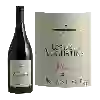
Château de ValflaunesEspérance
In the mouth this red wine is a powerful with a nice balance between acidity and tannins.
This wine generally goes well with beef, veal or pasta.
Taste structure of the Espérance from the Château de Valflaunes
Light | Bold | |
Smooth | Tannic | |
Dry | Sweet | |
Soft | Acidic |
In the mouth the Espérance of Château de Valflaunes in the region of Languedoc-Roussillon is a powerful with a nice balance between acidity and tannins.
Wine flavors and olphactive analysis
On the nose the Espérance of Château de Valflaunes in the region of Languedoc-Roussillon often reveals types of flavors of cherry, black cherries or plum and sometimes also flavors of leather, pepper or black currant.
Food and wine pairings with Espérance
Pairings that work perfectly with Espérance
Original food and wine pairings with Espérance
The Espérance of Château de Valflaunes matches generally quite well with dishes of beef, pasta or veal such as recipes of cataplana with seafood, the corsican soup or roast veal with caramelized carrots.
Details and technical informations about Château de Valflaunes's Espérance.
Discover the grape variety: Mourvèdre
Mourvèdre noir is a grape variety originating from Spain. It produces a variety of grape specially used for wine making. It is rare to find this grape to eat on our tables. This variety of grape is characterized by medium to large bunches, and grapes of medium size. Mourvèdre noir can be found in several vineyards: South-West, Cognac, Bordeaux, Provence & Corsica, Rhône valley, Languedoc & Roussillon, Loire valley, Savoie & Bugey, Beaujolais.
Last vintages of this wine
The best vintages of Espérance from Château de Valflaunes are 2010, 2008, 2018, 2017 and 2016.
Informations about the Château de Valflaunes
The Château de Valflaunes is one of of the world's greatest estates. It offers 10 wines for sale in the of Pic-Saint-Loup to come and discover on site or to buy online.
The wine region of Pic-Saint-Loup
The wine region of Pic-Saint-Loup is located in the region of Languedoc of Languedoc-Roussillon of France. Wineries and vineyards like the Domaine Ermitage du Pic Saint Loup or the Domaine de Villeneuve produce mainly wines red, pink and white. The most planted grape varieties in the region of Pic-Saint-Loup are Mourvèdre, Roussanne and Viognier, they are then used in wines in blends or as a single variety. On the nose of Pic-Saint-Loup often reveals types of flavors of earth, straw or apricot and sometimes also flavors of peach, dark chocolate or anise.
The wine region of Languedoc-Roussillon
Languedoc (formerly Coteaux du Languedoc) is a key appellation used in the Languedoc-Roussillon wine region of southern France. It covers Dry table wines of all three colors (red, white and rosé) from the entire region, but leaves Sweet and Sparkling wines to other more specialized appellations. About 75% of all Languedoc wines are red, with the remaining 25% split roughly down the middle between whites and rosés. The appellation covers most of the Languedoc region and almost a third of all the vineyards in France.
The word of the wine: Retrieved from
Wine that has lost its aromatic potential after prolonged aeration.














